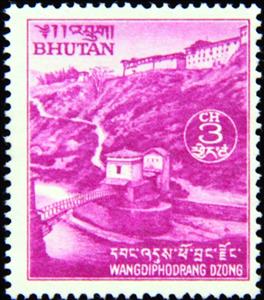Stamp: Wangdiphondrang Dzong and Bridge (Mauve) (Bhutan 1972)
Wangdiphondrang Dzong and Bridge (Mauve) (Bhutan 1972)
01 April (Bhutan ) within release Wangdiphondrang Dzong and Bridge goes into circulation Stamp Wangdiphondrang Dzong and Bridge (Mauve) face value 3 Bhutanese chhertum
| Stamp Wangdiphondrang Dzong and Bridge (Mauve) in catalogues | |
|---|---|
| Michel: | Mi:BT 508 |
| Stanley Gibbons: | Sg:BT 247 |
Stamp is square format.
Bridge over a river with a castle on the heightsAlso in the issue Wangdiphondrang Dzong and Bridge:
- Stamp - Wangdiphondrang Dzong and Bridge (Grey) face value 2;
- Stamp - Wangdiphondrang Dzong and Bridge (Mauve) face value 3;
- Stamp - Wangdiphondrang Dzong and Bridge (Violet) face value 4;
Stamp Wangdiphondrang Dzong and Bridge (Mauve) it reflects the thematic directions:
A bridge is a structure built to span physical obstacles without closing the way underneath such as a body of water, valley, or road, for the purpose of providing passage over the obstacle. There are many different designs that each serve a particular purpose and apply to different situations. Designs of bridges vary depending on the function of the bridge, the nature of the terrain where the bridge is constructed and anchored, the material used to make it, and the funds available to build it.
A castle (from Latin: castellum) is a type of fortified structure built in Europe and the Middle East during the Middle Ages by European nobility. Scholars debate the scope of the word castle, but usually consider it to be the private fortified residence of a lord or noble. This is distinct from a palace, which is not fortified; from a fortress, which was not always a residence for nobility; and from a fortified settlement, which was a public defence – though there are many similarities among these types of construction. Usage of the term has varied over time and has been applied to structures as diverse as hill forts and country houses. Over the approximately 900 years that castles were built, they took on a great many forms with many different features, although some, such as curtain walls and arrowslits, were commonplace.
A river is a natural freshwater stream that flows on land or inside caves towards another body of water at a lower elevation, such as an ocean, lake, or another river. A river may run dry before reaching the end of its course if it runs out of water, or only flow during certain seasons. Rivers are regulated by the water cycle, the processes by which water moves around the Earth. Water first enters rivers through precipitation, whether from rainfall, the runoff of water down a slope, the melting of glaciers or snow, or seepage from aquifers beneath the surface of the Earth.



